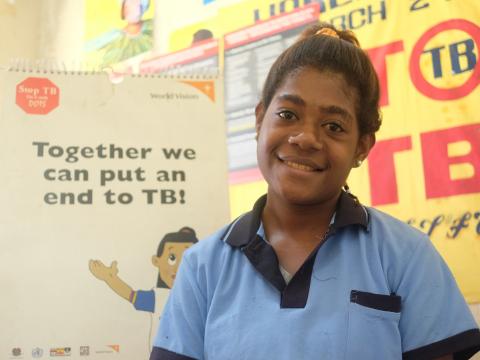Building Quality Care and Support for People Living with Tuberculosis

Consistent support from family members, health facilities, and communities play a crucial role in the prevention and treatment of Tuberculosis (TB).
However, due to weak capacity and major shortage of health staff, TB clinics and laboratories in the country are hardpressed with meeting even the minimum government standards of quality TB diagnosis and care. The crucial follow-on treatment is also weak due to the lack of TB treatment supporters providing directly observed treatment to TB patients.
With assistance from World Vision Papua New Guinea, and funding support from Global Fund and World Vision Australia, the National Tuberculosis Program (NTP) is building the capacity of 28 of its least performing TB clinics located in nine of its highest TB-burden provinces in the country. These clinics contribute to more than half of the TB cases reported nationwide.
World Vision deployed Liaison Officers in each of the priority TB clinics to provide all-around assistance to health staff and enable greater community support for TB patients. Liason Officers have led TB education sessions for communities and workplaces, organized monthly meetings with TB patients and treatment supporters, helped health staff gather and transport quality sputum specimen for immediate diagnosis, and ensured steady supply of TB drugs for patients.
World Vision TB Liaison Officer Dorothy Derevi releases daily food vouchers for people with drug-resistant TB in Port Moresby General Hospital. Daily medication, coupled with proper nutrition support, helps TB patients get well. (Photo: Tanya Hisanan/World Vision)
World Vision is also helping NTP re-energize its TB treatment supporters program to enable active TB case finding and consistent provision of directly observed treatment for TB patients. The effort is being pilot-tested in three provinces, namely Madang, Morobe, and the National Capital District.
Susan Agada, 53, is one of a growing number of TB treatment volunteers in Port Moresby. She comes to the clinic everyday on weekdays to help file TB patients' records. (Photo: Tanya Hisanan/World Vision)
As a sustainability measure, World Vision helped recruit and deploy staff at the National Department of Health and provincial health offices to provide coordination support for trainings; improvement in TB diagnosis (eg. roll-out of GeneXpert, perform TB culture, strengthening TB microscopy quality assurance); procurement and supply chain management of anti-TB drugs to ensure availability and access to medicine; and monitoring, supervision and evaluation.
A community health worker in one of the Global Fund-supported clinics explains to a TB patient how medication should be taken. Proper patient education and counseling is one of the key factors that motivate people to complete their treatment. (Photo: Tanya Hisanan/World Vision)
This integrated approach has gradually yielded gains for the TB program as evidenced by 29,000 cases reported in 2015. World Vision has also seen a reduction of people dropping out of treatment from 20 percent in 2013 to 16 percent in 2015 as well as increase in the number of people completing their treatment not only in priority clinics but nationwide from 68 percent in 2013 to 70 percent in 2015.